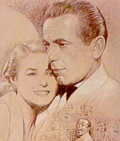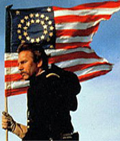Factual mistakes in The Untouchables (1987)
-
We see a British double decker bus on the streets of Chicago. The first Routemaster double decker bus was first introduced in 1956 so the existence of such a bus in the 1920's is impossible. Also, given its UK layout, designed for travel on the left side of the road, any passengers getting off would do so into the middle of the traffic. 1
-
The film, like the television series, exaggerates the role Ness and his men played in the capture of Al Capone (most notably his involvement in Capone's trial and eventual conviction on tax evasion charges). 2
-
In the film, there are only four "Untouchables": Ness, Jim Malone, Oscar Wallace, and George Stone. However, according to Ness' biography, there were actually ten of them, including himself. Malone, Wallace and Stone are fictional characters. Malone's real-life counterpart may have been Martin Lahart, an Irish-American from a family of cops who served as Ness's second-in-command. However, Ness and Lahart were both in their 20's at the time of the Capone investigation, and Lahart was born in the U.S., not Ireland. According to Charles Martin Smith in the Special Collector's Edition DVD feature The Script, The Cast, Wallace, the bespectacled agent with the accounting background, was loosely modeled on Frank Wilson, the Treasury Agent who commanded the team of IRS investigators who put together the tax evasion case against Capone. 2
-
While Ness and his real Untouchables did battle with Capone's organization, they had little to do with assembling the tax evasion case that would ultimately send Capone to prison. That case was put together by the criminal investigations unit of the Internal Revenue Service separately from Ness' efforts, though some of the evidence used to assemble that case included financial records seized by Ness during raids. Similarly the IRS unit would pass information on to Ness's squad about the location of breweries, stills, etc. 2
- Ness's main strategy in his war with the Capone mob was raiding breweries. Breweries represented a major investment of capital and putting one out of commission simultaneously constituted an immediate major loss of assets due to the confiscation of the equipment, and a future major loss of income due to the crippling effect the raids had on the Mob's ability to provide a saleable product. In the film, Ness and his squad make one raid on a liquor warehouse, and intercept an international shipment of liquor coming across the Canadian border, but do not raid one single brewery. 2
- Contrary to the meetings in the film, the real Capone and Ness never actually met face to face before the trial of Capone. 2
- The baseball scene in which Capone bludgeons a mobster was somewhat fictional, although there was a similar incident like this in 1929 where he bludgeoned three mobsters to death; John Scalise, Albert Anselmi, and Joseph "Hop Toad" Giunta. 2
- Two of the four Untouchables are killed in the movie. In real life, none of the actual Untouchables were killed, though some were injured during their battles against the mob. Frank Basile, an associate of Ness's prior to the formation of the squad, was killed, but he was not officially an agent. Of note, the two Untouchables who are killed drink or prepare to drink alcohol at some point in the film.
During the trial scene, Nitti is shown to have bribed the jury of Capone's trial into acquitting Capone of all charges. The judge then substitutes another jury for the tainted one. (This makes little sense, as, in the film, the trial is well underway at the time of the jury-switch, meaning the new jury would be asked to decide a trial in which they'd missed the bulk of the evidence and testimony.) In reality, Nitti was ruling Capone's crumbling empire, while enforcers attempted to tamper with the pool of potential jurors that had been assembled before the trial began. The judge then replaced the pool of potential jurors with another pool that had been assembled for a different trial. 2
- The judge in the trial is depicted as a grafter, who only switches juries after being threatened with public exposure of his corruption. In fact, the judge in the Capone trial, James Wilkerson, had a well-deserved reputation for probity and integrity, and the idea for switching the jury pools prior to the beginning of the trial was entirely his. 2
- In the film, Capone's lawyer pleads his client guilty over his client's vehement protests. In real life, Capone pled not guilty, and the trial went to verdict. A defense lawyer in a criminal trial would not be allowed to plead guilty on behalf of his client without the client's consent. 2
- The final confrontation between Ness and Nitti, in which the latter falls to his death, is entirely fiction. In fact, Nitti spent nearly six years running the empire after the fall of Capone, and he committed suicide in March 1943 upon learning of his possible jail sentence. The Capone minion who was discovered carrying a gun in court, and who was later found to have a list of the jury pool in his pocket, was Phil D'Andrea, not Nitti. And the discovery led to a quiet arrest, not a rooftop shootout. 2
- In the film, Ness and his squad are referred to as "Treasury Agents." In fact, at the time of the Capone investigation, the Bureau of Prohibition, the agency Ness worked for, was part of the Department of Justice, and had been since 1930. 2
- In the film Ness is depicted as a family man with a wife, a daughter, and a son on the way. In real life, the thrice-married Ness was a bachelor during most of the Capone investigation. He only had one child, a son he adopted with his third wife, long after his law enforcement career had ended. 2
1 From Moviemistakes.com
2 http://en.wikipedia.org/wiki/The_Untouchables_%281987_film%29), Wikipedia Article on The Untouchables.
|

